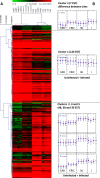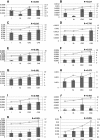Physiological change under OsHV-1 contamination in Pacific oyster Crassostrea gigas through massive mortality events on fields
- PMID: 23987141
- PMCID: PMC3766697
- DOI: 10.1186/1471-2164-14-590
Physiological change under OsHV-1 contamination in Pacific oyster Crassostrea gigas through massive mortality events on fields
Abstract
Background: Massive mortalities have been observed in France since 2008 on spat and juvenile Pacific oysters, Crassostrea gigas. A herpes virus called OsHV-1, easily detectable by PCR, has been implicated in the mortalities as demonstrated by the results of numerous field studies linking mortality with OsHV-1 prevalence. Moreover, experimental infections using viral particles have documented the pathogenicity of OsHV-1 but the physiological responses of host to pathogen are not well known.
Results: The aim of this study was to understand mechanisms brought into play against the virus during infection in the field. A microarray assay has been developed for a major part of the oyster genome and used for studying the host transcriptome across mortality on field. Spat with and without detectable OsHV-1 infection presenting or not mortality respectively were compared by microarray during mortality episodes. In this study, a number of genes are regulated in the response to pathogen infection on field and seems to argue to an implication of the virus in the observed mortality. The result allowed establishment of a hypothetic scheme of the host cell's infection by, and response to, the pathogen.
Conclusions: This response shows a "sensu stricto" innate immunity through genic regulation of the virus OsHV-1 life cycle, but also others biological processes resulting to complex interactions between host and pathogens in general.
Figures





References
-
- Farley CA, Banfield WG, Kasnic GJ, Foster WS. Oyster herpes-type virus. Science. 1972;83:176–179. - PubMed
-
- Nicolas JL, Comps M, Cochennec N. Herpes-like virus infecting Pacific oyster larvae, Crassostrea gigas. B Eur Assoc Fish Pat. 1992;12:11–13.
-
- Renault T, Cochennec N, Le Deuff RM, Chollet B. Herpes-like virus infecting Japanese oyster (Crassostrea gigas) spat. B Eur Assoc Fish Pat. 1994;14:64–66.
-
- Renault T, Le Deuff RM, Cochennec N, Maffart P. Herpesviruses associated with mortalities among Pacific oyster, Crassostrea gigas, in France - Comparative study. Revue Médicale Vétérinaire. 1994;145:735–742. - PubMed
-
- Le Deuff RM, Renault T, Gérard A. Effects of temperature on herpes-like virus detection among hatchery-reared larval Pacific oyster Crassostrea gigas. Dis Aquat Organ. 1996;24:149–157.
Publication types
MeSH terms
LinkOut - more resources
Full Text Sources
Other Literature Sources
Molecular Biology Databases

